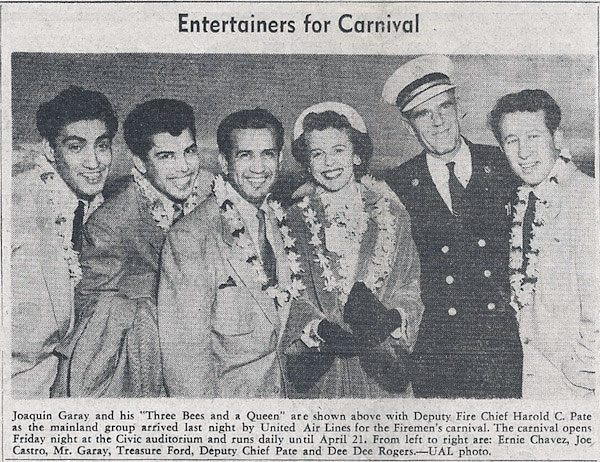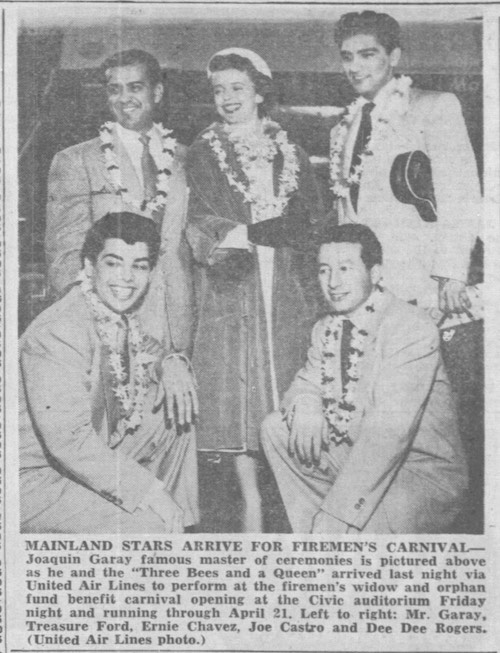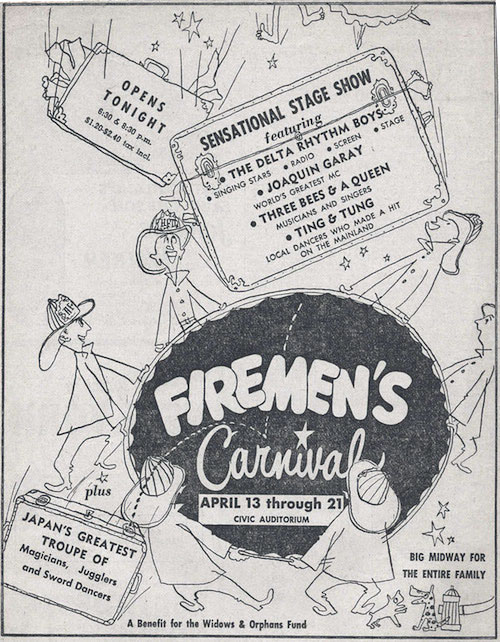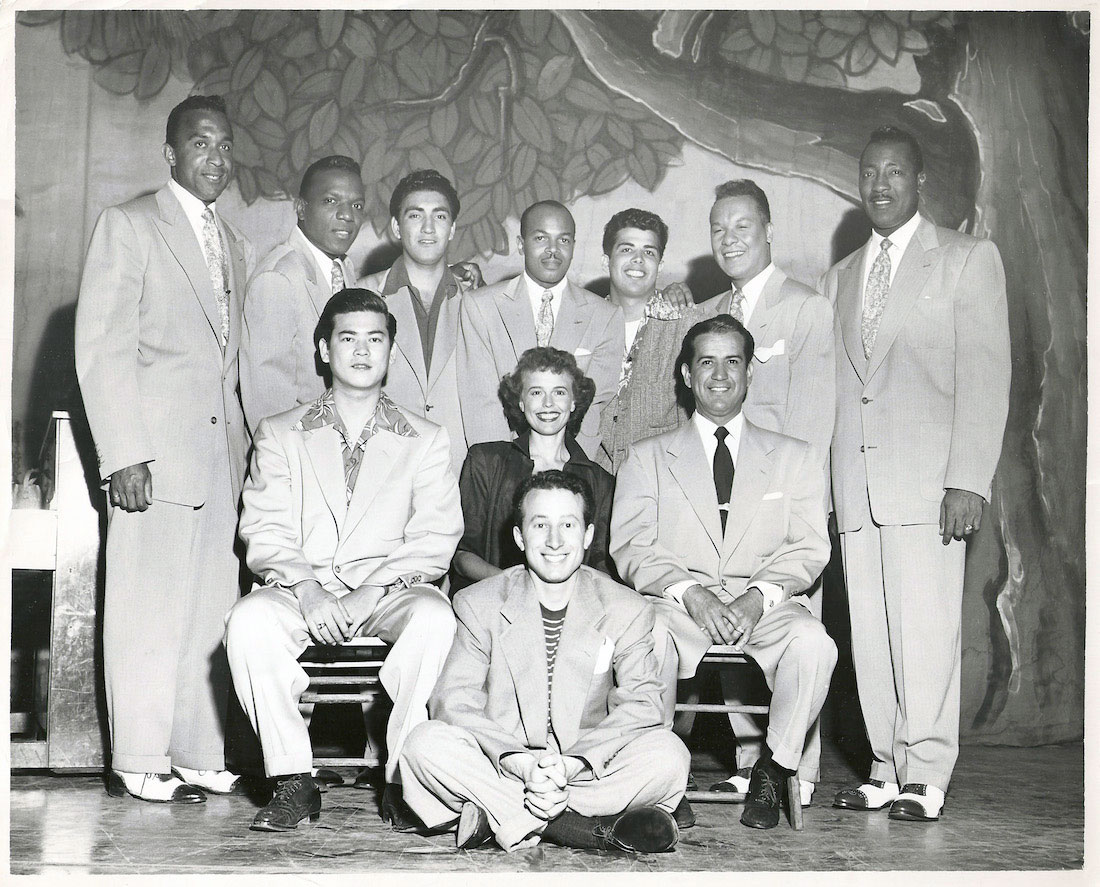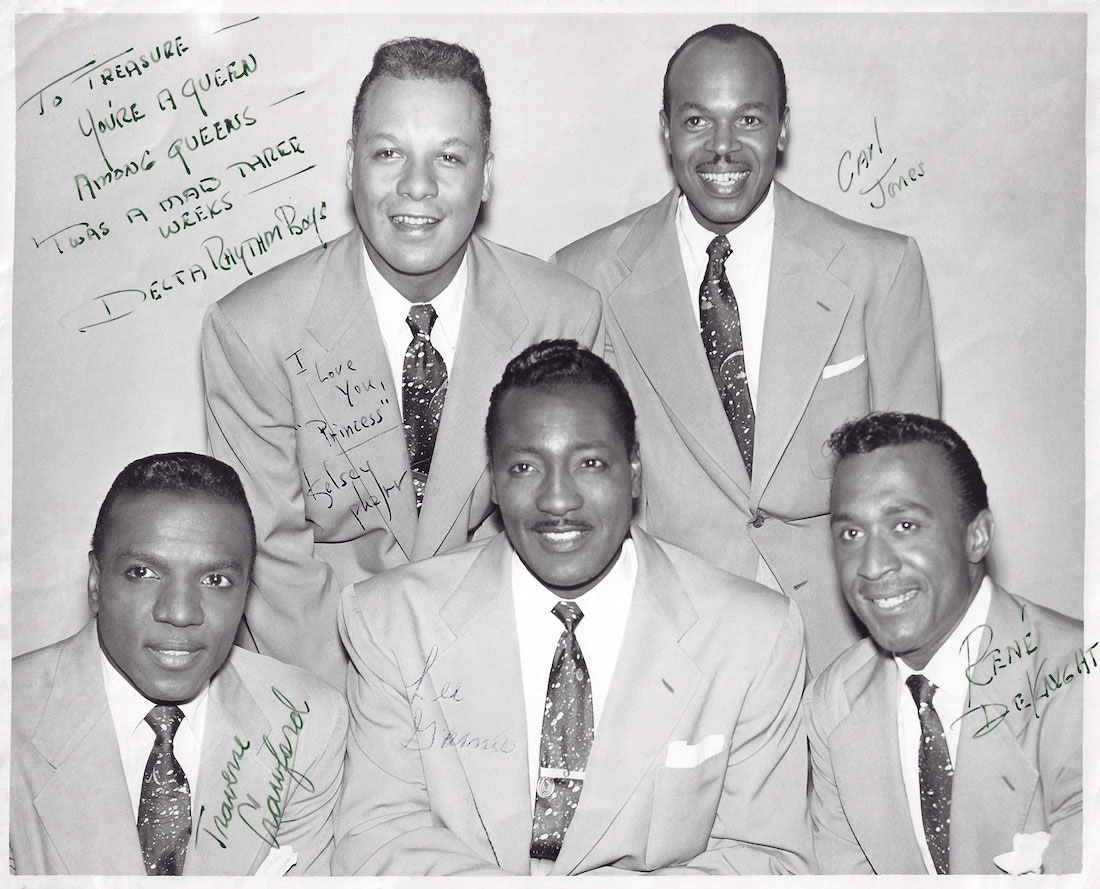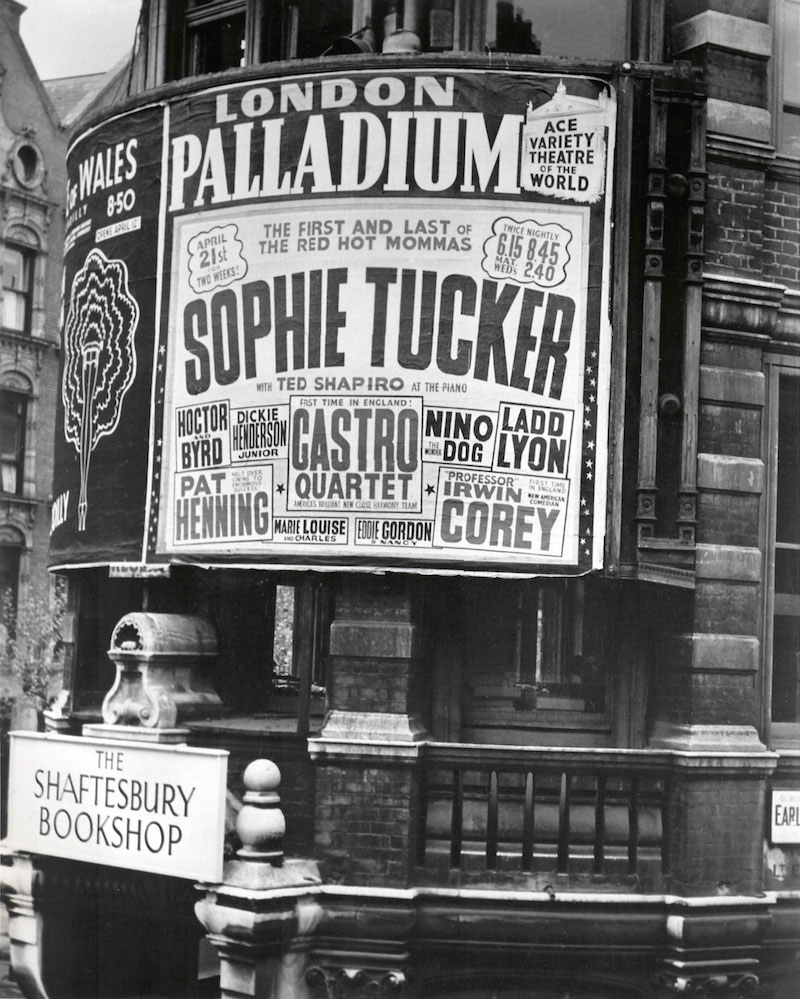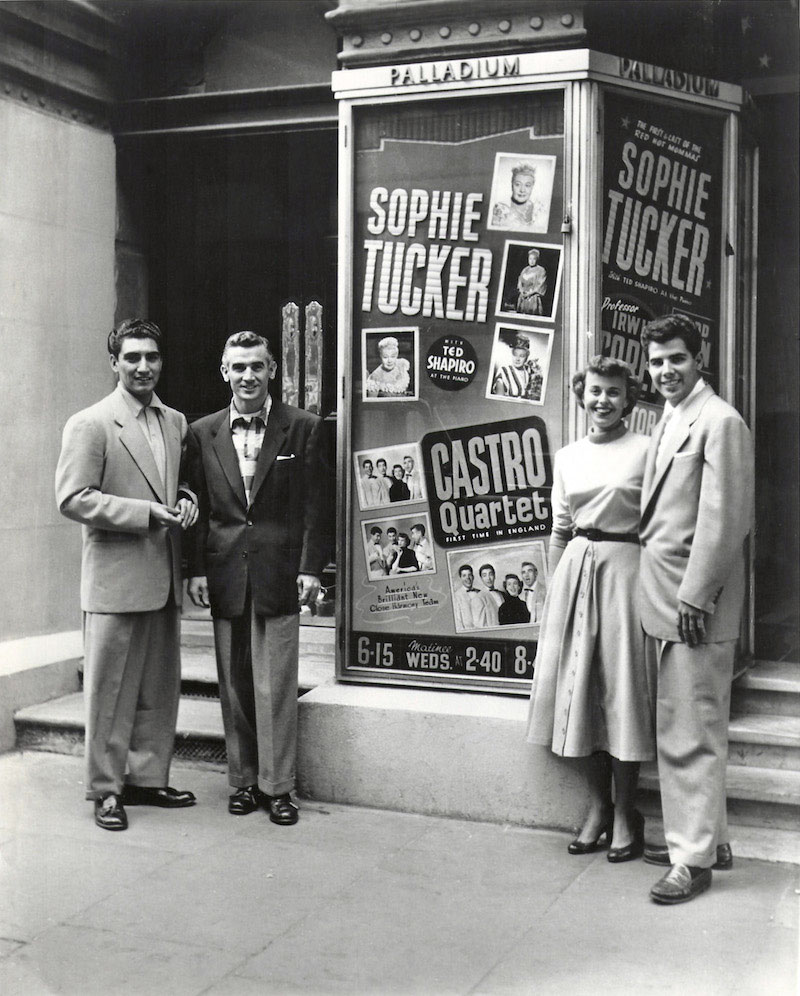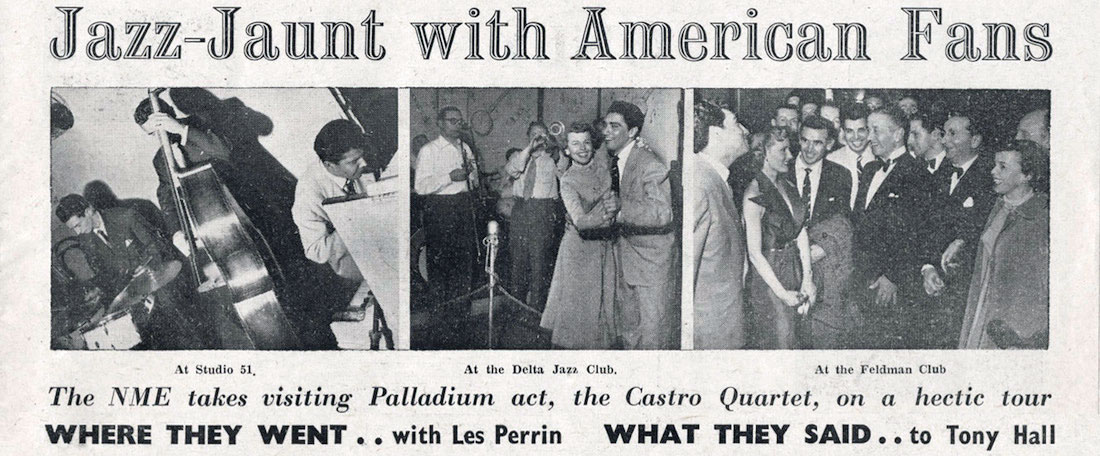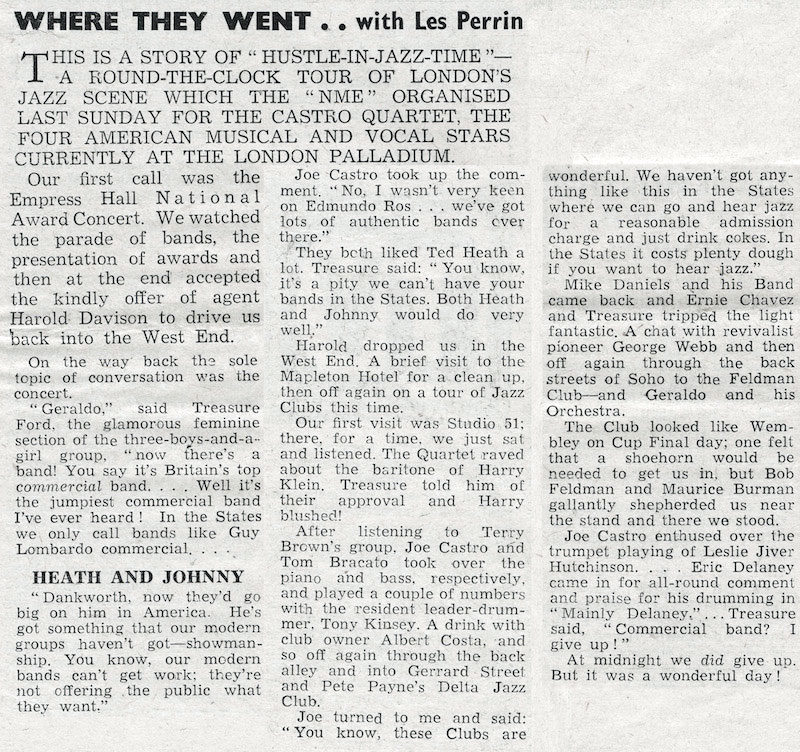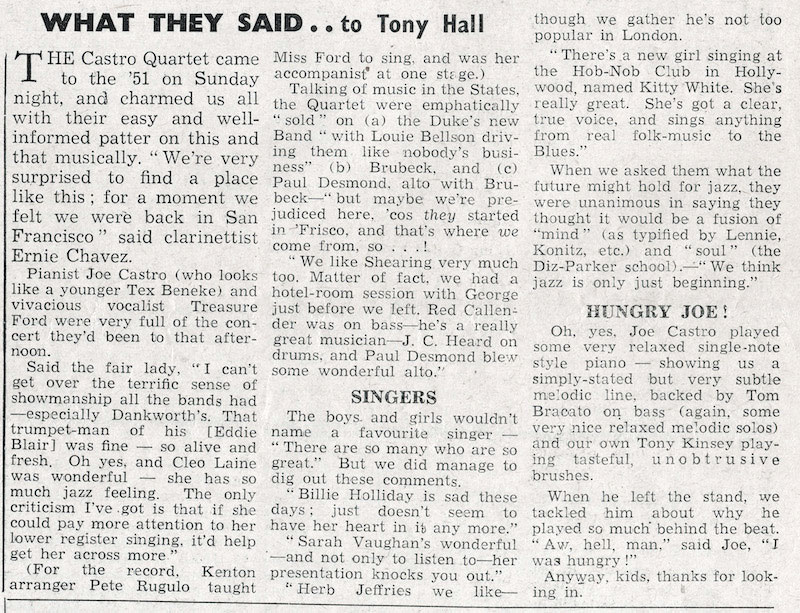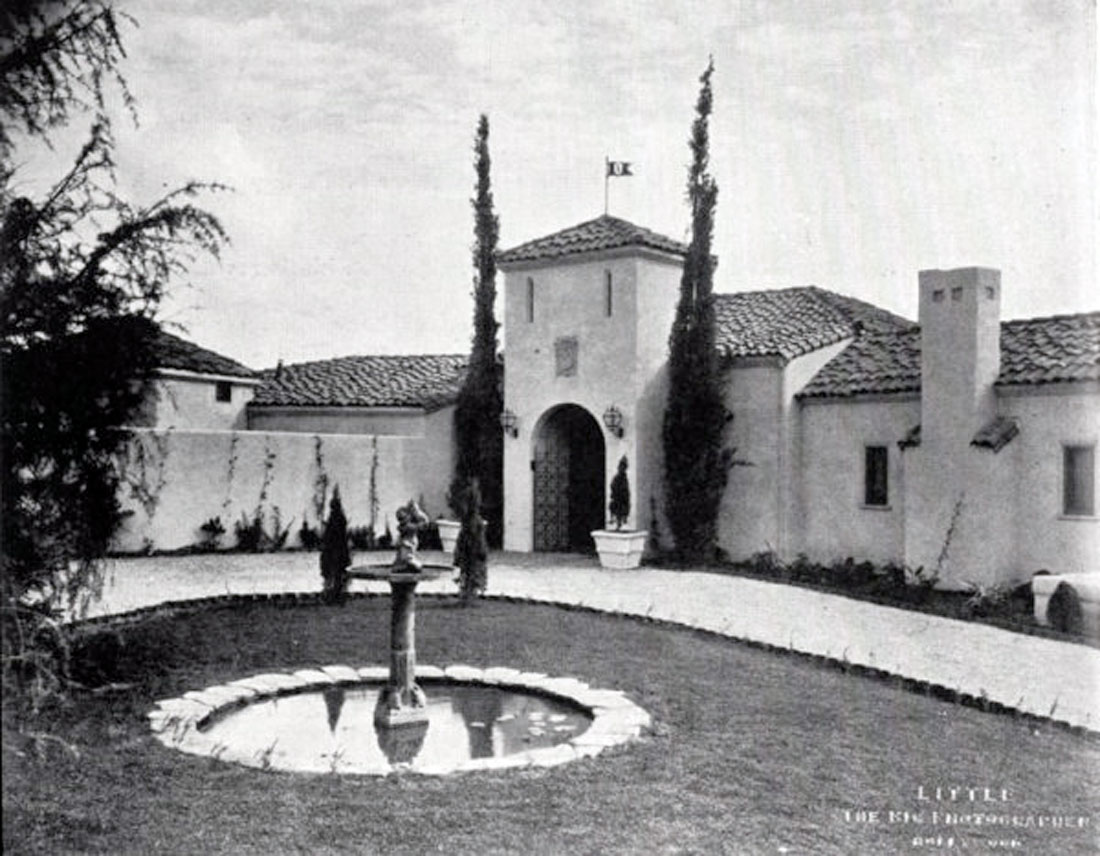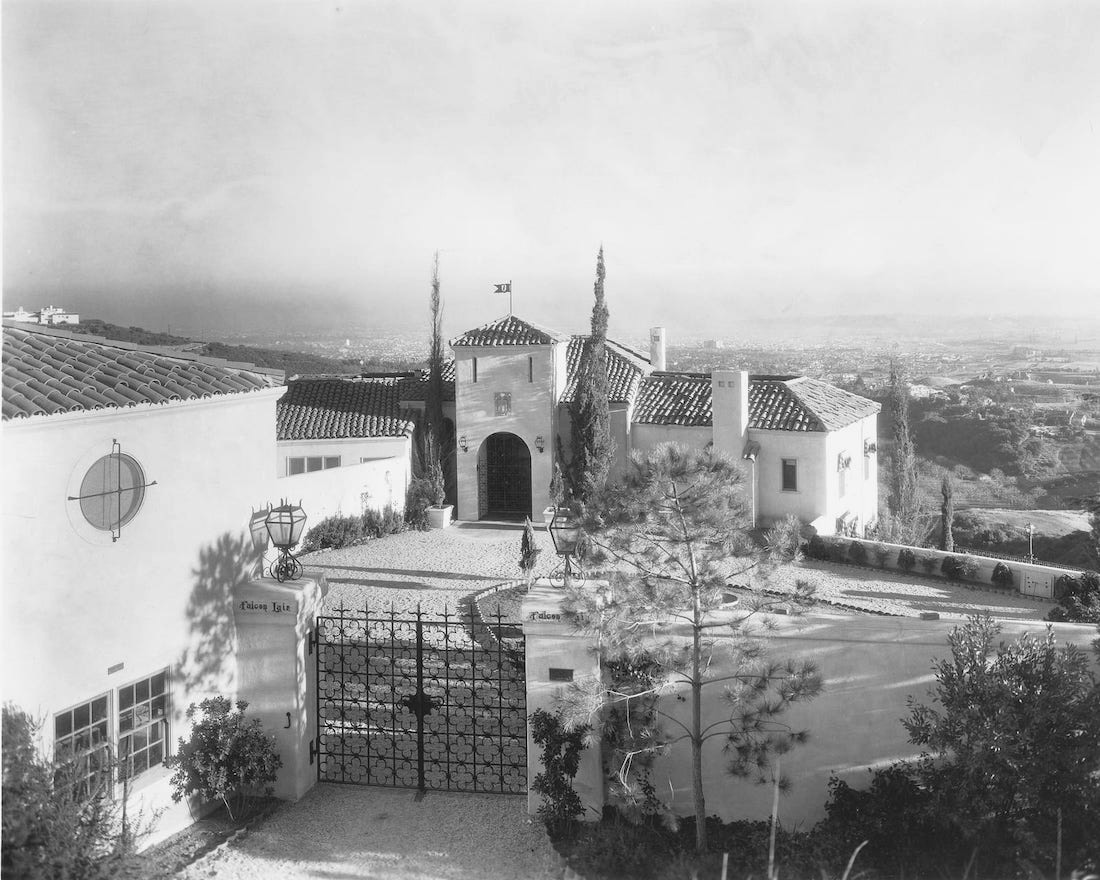3 Bees and a Queen left on a United Air flight from San Francisco to Honolulu on April 11, 1951.[•],[•]
The trip to Hawaii would be a turning point for the group and especially poignant for young Castro, who would meet an important influence and love interest, Doris Duke.
Together with Ford, Chavez and recent addition bassist Dee Dee Lucido (another friend from Pittsburg), Castro made his way to Honolulu where 3 Bees and a Queen were scheduled to perform on Friday, April 13th at the Fireman’s Carnival at the Honolulu Civic Auditorium.[•]
There were four acts that performed daily for nine days, including The Delta Rhythm Boys, Ting & Tung, Joaquin Garay (Castro led the orchestra for Garay’s performances) and 3 Bees and a Queen. The orchestra for the Carnival was conducted by Ray Tanaka and was a twelve or fourteen piece ensemble.

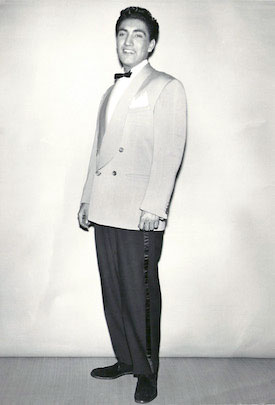
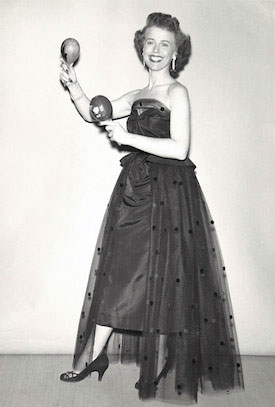
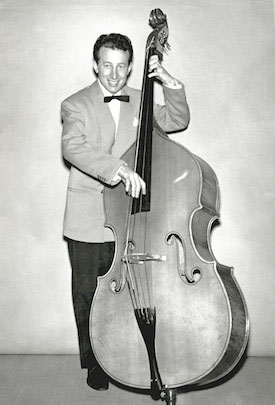
(James Castro Collection)
The jazz community in Honolulu was small but very active.
Castro: There was a club next to Moana [Hotel] called the Orchid Room[•] which featured jazz and we met the two local jazz beboppers; Al Baang who played alto and there was bass player Marcelo Aspera, he was Filipino or Hawaiian. They were delightful. There was also a singer, Edna Alexander, whom I knew for many years. A very good singer. We’d go over and jam and things like that. That’s how we got to know them....
When they weren’t performing, the group would meet at Kau Kau Korner. Dave Brubeck and Cal Tjader were playing at the nearby Zebra Lounge. Brubeck had relocated from California to Hawaii for this gig for some time. Castro even subbed for him as Brubeck had hurt his neck while diving into the ocean, an incident Castro recalled as it was a serious injury to Brubeck which ailed him for some time.[•]

(William Bixler Collection)[•]
During the first weekend of the engagement, someone mentioned to Castro that there was a famous person in the audience. It happened to be Doris Duke, the wealthy heiress to the Duke tobacco fortune.
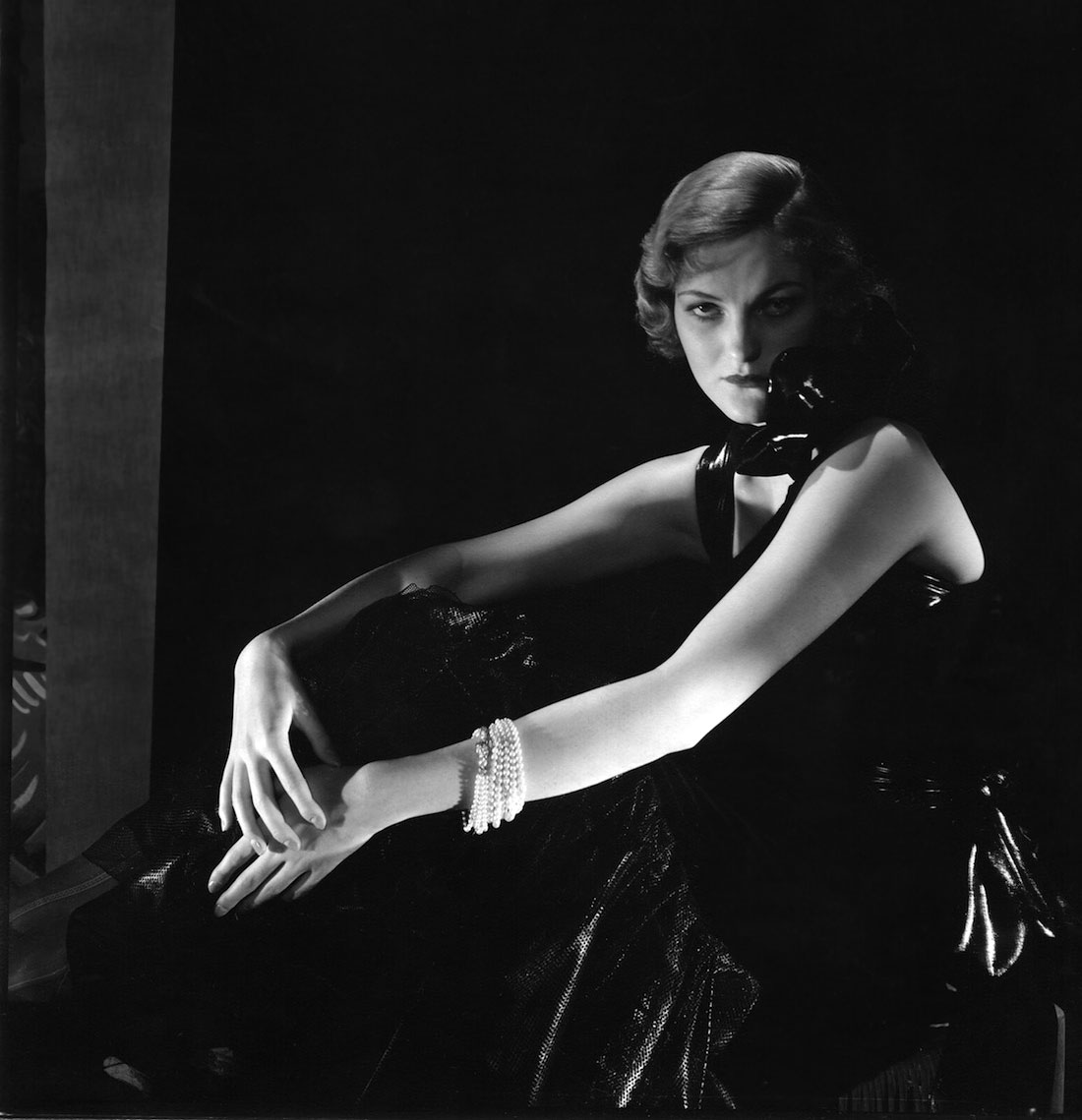
(Doris Duke Photograph Collection, 1870-2006, David M. Rubenstein Rare Book & Manuscript Library, Duke University, Durham, North Carolina)
Daughter to tobacco tycoon James Buchanan Duke and Nanaline Holt Inman, Duke had grown up in the public spotlight. She had already traveled the world and had many interests, including competition surfing, which she had pursued in Hawaii. Duke was nearly 15 years older than the young pianist.
Castro met Duke after a performance and she invited him back to her home, Shangri La, to help teach her to play jazz piano. Duke had been a part time resident of Hawaii for some time. She had a property, Shangri La, upon which construction began in 1936. The home was located near Diamond Head outside of Honolulu and was built in a fashion and ornamented with Islamic art, which Duke had become fond of on her honeymoon travels with her first husband James H.R. Cromwell in 1935. The estate has since become a museum of Islamic art.[•]
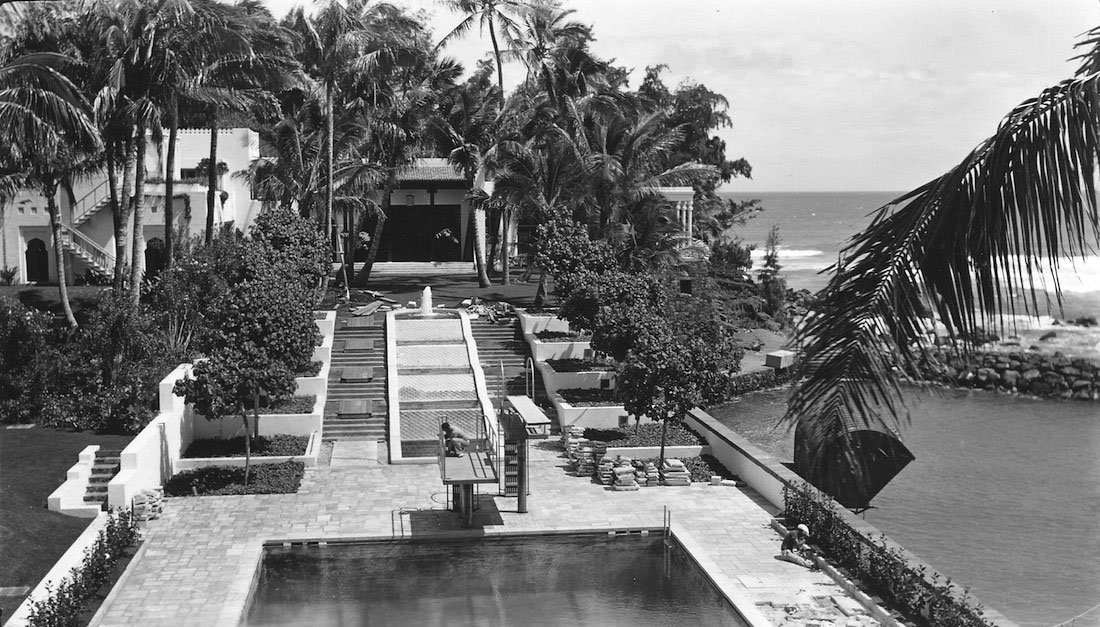
Shangri La, the cascade area, circa 1938
(Doris Duke Photograph Collection, 1870-2006, David M. Rubenstein Rare Book & Manuscript Library, Duke University, Durham, North Carolina)
Duke had an interest in music, having studied some piano. She had an interest in classic jazz but was enamored with R&B. Quite by accident, the occasion that had precipitated their meeting was Duke’s delayed flight to New York whereupon she looked for some entertainment and decided to go to the Fireman’s Carnival to enjoy the show, most likely the Sunday of the first weekend. She had noticed Castro and reached out to him.
As they began to spend time together, Castro began to introduce Duke to the importance of modern jazz music with examples from en vogue progressives like Dizzy Gillespie and Charlie Parker. She was impressed by Castro’s piano playing and personality, so much so, she invited him to come back for proper lessons nearly every day. Shangri La’s Playhouse housed two Steinway pianos back to back and became the site for several jam sessions shortly thereafter.
3 Bees and a Queen were scheduled to tour Maui and Kauai along with the same lineup from the Fireman’s Carnival, ending on April 21st. They were to be away for a little over a week, performing at Kaneohe,[•] Roosevelt Theater[•] in Honolulu, Maui, Kauai and the Lau Yee Chai club[•] (two shows a night) in Honolulu. Duke was due to fly back to New York, as she did frequently as part of her business. These visits were always short and she would typically return after a few days via a twelve-hour flight.
Duke was back in Honolulu at the end of the 3 Bees and a Queen’s official employment. Thereupon she asked Castro if he would stay in Hawaii. As he was thinking of the other members of the ensemble, Castro was concerned at the cost of keeping the other three musicians on the island and paid. He figured that it would cost $75 a week for each member to stay and $300 a week for his services as a piano teacher. The situation wasn’t suitable for the other members of the group and they returned home, canceling a gig in the Northwest, but still receiving a check as if they had played it. Duke did eventually settle on paying the group a year’s salary.
So Castro stayed on in Hawaii. He lived at the Moana Hotel and was picked up daily to visit Shangri-La.
During the summer, the two went to Los Angeles for a change of scenery, staying at Duke’s usual Los Angeles retreat, the Bel Air Hotel.
Though 3 Bees and a Queen were essentially broken up at this point, the group had to travel to Pasco, Washington to make up one of the engagements that had been cancelled due to Castro’s stay in Hawaii, while Duke went to Damascus.
Duke sent a telegram to Castro on his 24th birthday to insure that he would remain in Los Angeles to teach while she would continue to pay the band in lieu of performances. Meanwhile, Ford stayed with Castro at the Sunset Colonial Hotel on the Sunset Strip.
While in Los Angeles, Castro and crew continued to look for gigs and hired another Pittsburg native, Maurice Duke, as their agent. Though the agent referred to the group as the “world’s greatest audition band,” and though, as Castro recalls: “When we got the gig we became disinterested,” Maurice Duke did manage to get them a job at Billy Gray’s Band Box[•] on Fairfax Avenue, under a new guise:
Joe Castro Players (three lads and a gal), possess plenty of spark. Foursome sings and mugs to sock over solid entertainment. Treasure Ford supplies the sex appeal and sings a cute tune especially Captain Kidd.[•]
It’s during that period that the first likely mention of a relationship between Castro and Duke was leaked by gossip columnist James Copp:
Doris Duke...seated in a deep armchair in the reception hall [at the Hyatt von Dehn’s house], listening, enraptured, to the piano playing of young Joe Castro (who opens at the Band Box a week from tomorrow)....[•]
Castro got to know former Duke Ellington vocalist Herb Jeffries, who charmed Doris Duke with dinner conversations about yogi, a current quasi-religious-health craze at the time. Castro would gig with Jeffries at the Showboat[•] in Oakland on February.[•]
The group was based at the Sunset Colonial Hotel in February 1952 when Duke asked Castro to fly back to Honolulu. He accepted and flew first class to Honolulu. Upon arriving, Castro was taken directly to Shangri La, where he stayed.
Castro: So off to Hawaii I go. By this time, she would call me “The Child of the Gods.” She called (ex-husband Porfirio) Rubirosa, “Rube” and I was “Johnny's Mexican Magic.” Most people called her “Dorshka.” The Hawaiians called her “Lahi Lahi.”
Upon his return to Los Angeles, Castro and the band auditioned for a job at the London Palladium[•] through the Lew & Leslie Grade Agency, which was procured by their friend René DeKnight of the The Delta Rhythm Boys. They were given a choice of flying to England in April, May or August. They chose to perform in April,[•] shoring up what would be their international première.
The ensemble, including Castro, Ford, Chavez and the returning Tom Brocato, stopped in Somerville, New Jersey before heading to England. They stayed at Duke Farms where Doris set up a couple of jam sessions that included friends Jeffries, Pearl Bailey and Tony Martinez in mid-April.[•]
They arrived in London on April 20th and their first night at the Palladium was on the 21st. The group, under the guise of the Castro Quartet, played the Palladium for two weeks, opening for vocalist Sophie Tucker.
Joe wrote to Doris:
Opening night was a panic! We were all tired and nervous. They intentionally throw a scare into everyone that works here. They cut our ballad out, I found out later that Sophie doesn’t let any girls sing on slow songs on her shows…. There are a few good acts on the show. The comedian we saw with Josephine Baker is on the show and he gave us some of the inside dope on the “bullshit” that goes on; he was here in the last show. The band is very good, but not the best, I’ve played with better…. We got second billing on the show, which entitled us to the silver plaque with our name on it which is supposed to be “the” honor. Sophie got one and so did Pat [Henning]…it is their version of the Hollywood Oscar. We’re learning so much on every show. The experience we are getting is incredible…. When we get back we’ll have to concentrate on making some records….[•]
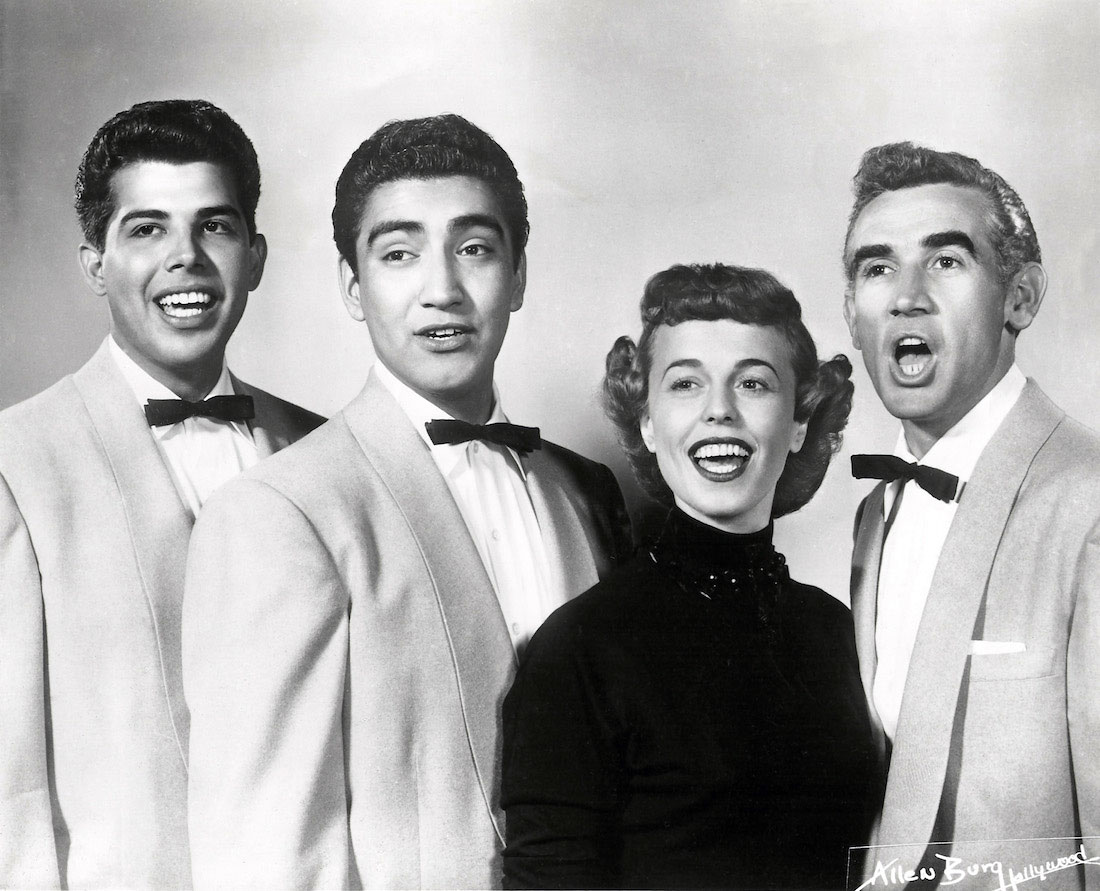
(James Castro Collection)
While in England, the group received an extremely positive writeup from The New Musical Express. This would be the biggest exposure the group would garner in their short career.
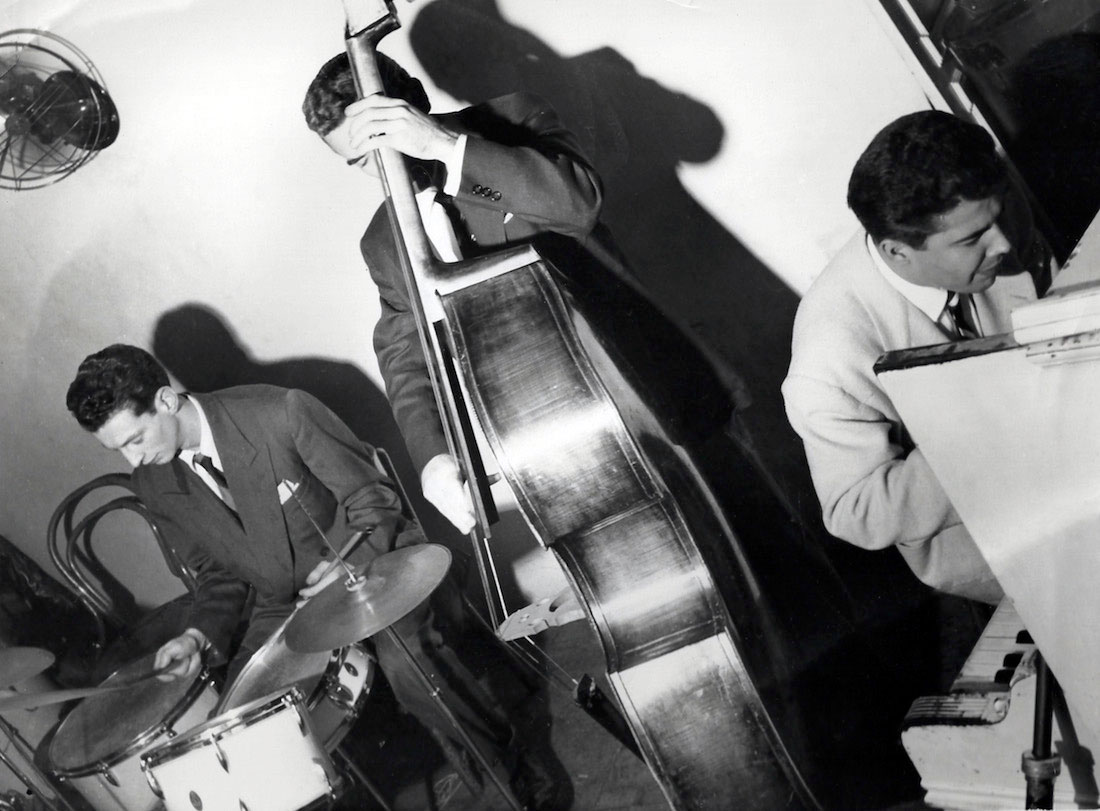
(James Castro Collection)
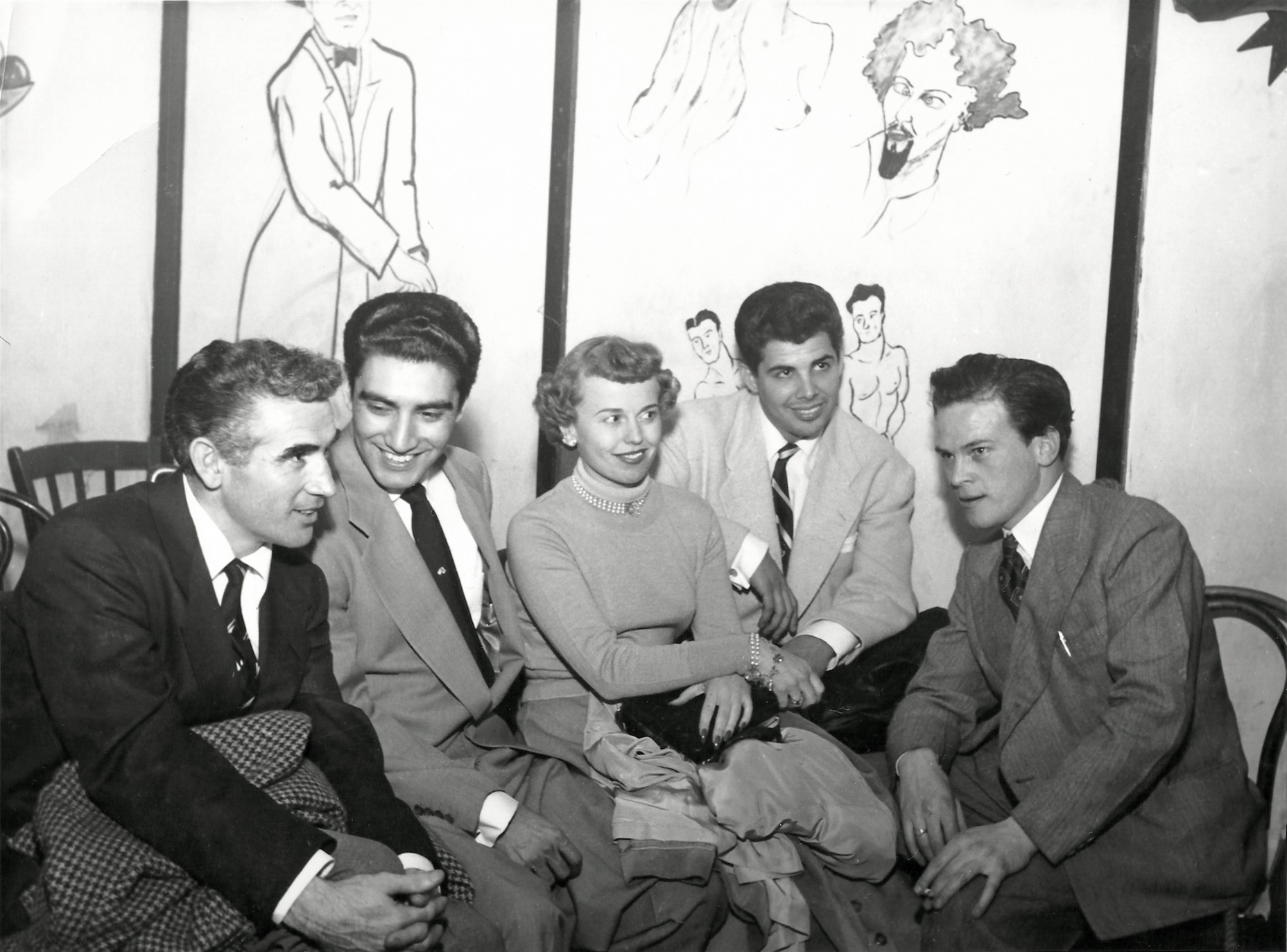
(James Castro Collection)
While at the Palladium, Castro was approached by a wealthy fan he knew from Washington State. The fan suggested the ensemble stay an additional two weeks and perform at his residence in Ipswich some 80 miles from London for the same pay they were receiving from the Palladium. The musicians changed their tickets and remained in England until May 26th when they flew to Paris for three days, which upset Duke as she had wanted to take Castro around and show him the city.
Having returned to the States by June, the band performed at Ridgecrest, California.
Castro: They got us a job at Ridgecrest, some stupid forsaken town out there with the sand, lousy place to live and even with the coffee shop sign “Direct from the London Palladium.” I couldn’t believe it, dumb blonde behind the bar, it was a rough place, it was stupid but we were already committed, so we did it, Doris used to come out on the day off....
It was during that period that Doris, according to Stephanie Mansfield in her biography of Duke, “went public” with Castro:
…Doris finally went public with Joey Castro, bringing him to a lavish party she threw at Cobina’s [Wright]…. Castro recalled the night: “Doris had all these drummers from Haiti, they all spoke French. She took this whole troupe and had a party on the lawn with all these torches. I'll never forget it. They all danced up and down. Doris had my little group playing there in case someone saw us and liked us, we'd get a break. Charlie Chaplin, Keenan Wynn, Robert Ryan, and Gilbert Roland were there. They used to call him ‘Amigo.'”[•]
Castro struck out on his own, as the 3 Bees were officially no more. It was around this time that the pianist had a chance to perform alongside Charlie Parker.[•] Castro’s friend, vocalist Kitty White, mentioned that Parker was in town and that Castro should come to meet the famed saxophonist at a jam session. There was no pianist, so the overwhelmed Castro had to sit in.
Castro: In about 1952, I had my encounter with Charlie Parker, the “King of Jazz” of course of the modern age. Kitty White, a singer from Los Angeles and a friend of mine, gave me a call and said, “You know Charlie Parker is going to be out in Malibu tonight at a jam session? Do you want to meet him? Come on...I can cook a chicken dinner.” So some of the 3 Bees and a Queen, Ernie, Treasure and I went out there. We arrive there is no piano player so that’s how I got asked to play, it was scary to play with Bird, but he was so nice, so charming and so great, sounding so fluid, so everything.Then Kitty did some numbers which I backed her on, I knew all her numbers from going to see her work, she liked to stand up when I played, so she wouldn’t have to be chained to the piano. He followed me, following her, it was just beautiful, he was sad to see me leave, I should have stayed longer, but we had a good time.
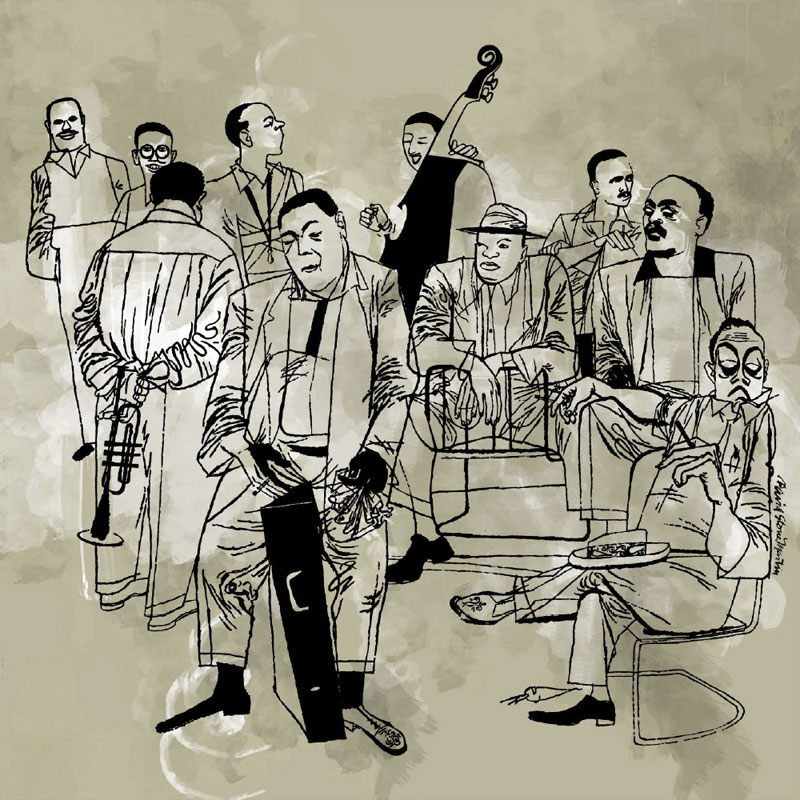

Before getting a steady gig in the fall at the Mocambo,[•] that was run by Duke’s friend, Charlie Morrison, Castro could be found performing at a café called Café Galla[•] on Sunset Boulevard. Castro had met Morrison earlier in the year while hanging with Duke. Morrison assumed that Castro played Latin music because of his name but Castro wasn’t versed in Latin music at all, telling Morrison he was a jazz musician. Morrison replied that: “If you can play Cole Porter, you can play Latin.”
Castro opened the club performing alongside vocalist Joanne Gilbert.
Regardless, Castro got the job at Mocambo[•] with an ensemble featuring Chico and Joe Guerrero and members of Desi Arnaz’s band as Johnny Alvarez. He also signed a management deal with Barbara Bell and Lee Newman,[•] Castro was able to get an apartment nearby on Sunset Boulevard.
The most decadent evening at Mocambo came on New Year’s Eve 1953 when Texas oilman Tevis F. Morrow rented out the entire club and invited a large menagerie of wealthy guests and celebrities, including Edith Piaf (who was performing at the club from December 23 to January 4),[•] Conrad Hilton and Doris Duke.
This was the time when Duke and Castro’s relationship was at its height. Hal Eaton wrote in his “Going to Town”:
Bop Pianist Doris Duke's Newest Heart Interest. Doris Duke completely gone on Joe Castro bop pianist. Talks nothing but jive....[•]

(James Castro Collection)
With their relationship flourishing and with money not an object, the couple looked for a home together. Castro maintained that: “I told Doris I don’t like this going to the hotel....” They decided to purchase Rudolph Valentino’s Falcon Lair in Beverly Hills. On March 24, 1953, the deed for Falcon Lair was granted.[•]
